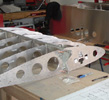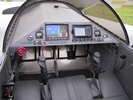


random user submitted photo
Flap Reflex
16 posts
• Page 2 of 2 • 1, 2
Re: Flap Reflex
At 1G and a higher weight, you are running at a higher AOA for a given speed. Less angle to go before stall.
Bryan Cotton
Poplar Grove, IL C77
Waiex 191 N191YX
Taildragger, Aerovee, acro ailerons
dual sticks with sport trainer controls
Prebuilt spars and machined angle kit
Year 2 flying and approaching 200 hours December 23
Poplar Grove, IL C77
Waiex 191 N191YX
Taildragger, Aerovee, acro ailerons
dual sticks with sport trainer controls
Prebuilt spars and machined angle kit
Year 2 flying and approaching 200 hours December 23
-

Bryan Cotton - Posts: 5381
- Joined: Mon Jul 01, 2013 9:54 pm
- Location: C77
Re: Flap Reflex
509sx wrote:I just don't get it, but I see everywhere this notion that maneuvering speed is weight dependent. If the weak link in the airframe is say, the motor mount, bomb racks, or seat structure, I could get that a G limit makes sense.
It IS the G limit that primarily dictates maneuvering speed. In addition the the last couple posts, consider this (very rough and unrealistic) example:
Aircraft is rated to +10 G's.
At 100kts, the wings can generate 10,000 lbs of lift before reaching critical angle of attack (stall).
At 150kts, the wings can generate 15,000 lbs of lift before reaching critical angle of attack (stall).
If the aircraft weighs 1000lbs, maneuvering speed is 100kts, because a higher airspeed might max the G-limit before the wing stalls (1000lbs x 10G = 10,000.)
If the aircraft weighs 1500lbs, maneuvering speed is 150kts, because a higher airspeed might max the G-limit before the wing stalls (1500lbs x 10G = 15,000.)
Maneuvering speed, in effect, imposes a maximum G-load airspeed on the aircraft. This speed varies depending on aircraft weight.
...
As is with any limitations, the engineering complexities need to be effectively dumbed-down for a pilot to have a a safety envelope to operate within with clear-cut standards that account for various safety aspects. I don't actually know (and don't want to find out) which part of my Waiex will break first if I perform a max-deflection maneuver above maneuvering speed, but I do know that weight changes my safety envelope for that airspeed, and if I operate within that envelope the margins should be reasonably safe.
I will say that the worst thing to do during a maximum G pull is try to induce a roll at the same time, as this imposes additional stress (via the aileron) at the outboard of the lifting wing that may exceed the envelope in an unexpected (to the pilot) manner.
Ryan Roth
N197RR - Waiex #197 (Turbo Aerovee Taildragger)
Knoxville, TN (Hangar at KRKW)
My project blog: http://www.rynoth.com/wordpress/waiex/
Time-lapse video of my build: https://www.youtube.com/watch?v=Q8QTd2HoyAM
N197RR - Waiex #197 (Turbo Aerovee Taildragger)
Knoxville, TN (Hangar at KRKW)
My project blog: http://www.rynoth.com/wordpress/waiex/
Time-lapse video of my build: https://www.youtube.com/watch?v=Q8QTd2HoyAM
-

Rynoth - Posts: 1308
- Joined: Fri Jul 26, 2013 1:32 pm
- Location: Knoxville, TN
Re: Flap Reflex
509sx wrote:But if the limit is wing bending moment, that is driven strictly by dynamic pressure (and AoA), and weight doesn't matter. In this case the issue is the maximum load the wing can generate at the AoA for max lift, just before stall.
I like and agree with Art's fundamental question and I think there's a lot of conflicting information about it. I think it ultimately depends on the design of the airplane and reducing Va as weight decreases is a safe way to avoid higher load factors on other parts of the airplane.
In the example Rynoth provided, the lighter airplane's wings were under much less stress, so the limit does not seem to be bending moment on the wing. Maybe the engine falls off or the seat collapses beyond 10Gs.
Of course, I don't believe you can do the reverse and safely increase weight beyond what's listed in the POH for Va and expect Va to also increase. In that direction, the limiting factor might actually be aerodynamic loads on the wings or other surfaces.
As evidence that there might be a little more to this, I've found two examples from POHs where a higher Va is listed at a lower weight. In both cases, the higher speed is listed under the Aerobatic category.
https://www.vansaircraft.com/wp-content ... speeds.pdf
RV 14 @ 2050lbs: 150 mph
RV 14 @ 1900lbs: 169 mph
https://www.extraaircraft.com/docs/serv ... -09-20.pdf
Extra @ 2095 lbs: 140 kts
Extra @ 1918 lbs: 158 kts
- gammaxy
- Posts: 596
- Joined: Wed Sep 04, 2013 9:31 am
Re: Flap Reflex
gammaxy wrote:As evidence that there might be a little more to this, I've found two examples from POHs where a higher Va is listed at a lower weight. In both cases, the higher speed is listed under the Aerobatic category.
https://www.vansaircraft.com/wp-content ... speeds.pdf
RV 14 @ 2050lbs: 150 mph
RV 14 @ 1900lbs: 169 mph
https://www.extraaircraft.com/docs/serv ... -09-20.pdf
Extra @ 2095 lbs: 140 kts
Extra @ 1918 lbs: 158 kts
This makes sense if dropping the weight puts the plane in a new category with a higher G-loading maximum. Although the actual reason the speed changed probably has more to do with C.G. and regulations.
There is certainly more to overstressing parts of an airframe than simply G-loading, but Va itself is determined a certain way and that's what we use, and we hope that it covers all aspects of overstressing the airframe at various speeds. I.e. it's partially (mostly?) a bureaucratic safety standard.
Ryan Roth
N197RR - Waiex #197 (Turbo Aerovee Taildragger)
Knoxville, TN (Hangar at KRKW)
My project blog: http://www.rynoth.com/wordpress/waiex/
Time-lapse video of my build: https://www.youtube.com/watch?v=Q8QTd2HoyAM
N197RR - Waiex #197 (Turbo Aerovee Taildragger)
Knoxville, TN (Hangar at KRKW)
My project blog: http://www.rynoth.com/wordpress/waiex/
Time-lapse video of my build: https://www.youtube.com/watch?v=Q8QTd2HoyAM
-

Rynoth - Posts: 1308
- Joined: Fri Jul 26, 2013 1:32 pm
- Location: Knoxville, TN
Re: Flap Reflex
I read somewhere that the wing was sandbag-tested, and failed at 10.5 Gs, based on 1100lbf gross weight. This is in F-16 territory!
With the typical 50% structural margin to ultimate, we have a 7G wing. I like having a strong airplane; it gives me confidence in turbulence. But as I was saying, a G-limit only makes sense if the airplane's structural integrity is limited by something other than the wing. Are there any known strength data for the motor mount? Here we have a fixed mass attached to the airframe, and how many multiples of the engine's weight the motor mount structure can support could drive a G-spec. Classically, though, it's the wing structure that's considered the driver, so the maneuvering speed is one value, irrespective of weight. If I'm not mistaken, the top of the green arc at 125 mph is really maneuvering speed, not max structural cruise speed, as on a certified airplane. The latter is driven by a gust criterion. The former is more conservative. The 6 G number is a standard minimum for aerobatic airplanes. I've never seen a payload weight minimum for aerobatic airplanes.
Art 509SX 2700cc Sonvair TD Southern WA
With the typical 50% structural margin to ultimate, we have a 7G wing. I like having a strong airplane; it gives me confidence in turbulence. But as I was saying, a G-limit only makes sense if the airplane's structural integrity is limited by something other than the wing. Are there any known strength data for the motor mount? Here we have a fixed mass attached to the airframe, and how many multiples of the engine's weight the motor mount structure can support could drive a G-spec. Classically, though, it's the wing structure that's considered the driver, so the maneuvering speed is one value, irrespective of weight. If I'm not mistaken, the top of the green arc at 125 mph is really maneuvering speed, not max structural cruise speed, as on a certified airplane. The latter is driven by a gust criterion. The former is more conservative. The 6 G number is a standard minimum for aerobatic airplanes. I've never seen a payload weight minimum for aerobatic airplanes.
Art 509SX 2700cc Sonvair TD Southern WA
- 509sx
- Posts: 20
- Joined: Fri Mar 13, 2020 11:58 pm
Re: Flap Reflex
The g meter in my Sonex once recorded 6.9g in turbulence. You really don't want to go there, or at least not too often. That was a high enough load so that the spars, where they cross over at the center of the fuselage, punched dents in the fuselage floor. A Solidworks model calculated a 4mm bend in the spar between the two wing attachment points and the dents protrude about 3mm which is pretty good confirmation.
Peter
Peter
- peter anson
- Posts: 553
- Joined: Thu Jul 31, 2014 2:34 am
- Location: Mount Macedon, Australia
16 posts
• Page 2 of 2 • 1, 2
Who is online
Users browsing this forum: No registered users and 136 guests







